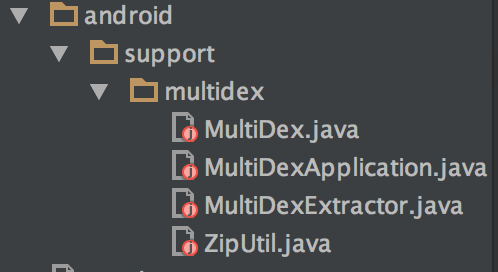通过源码看android系列之multidex库
我们在开发项目时,喜欢引入好多的第三方包,大大的方便了我们的开发,但同时,因为android方法总数的限制,不能超过65k,然而呢,随着我们的开发,65k最终还是会超过,所以,google就给出了这个解决方案,但一直好奇它是内部是怎么实现的,我们今天就来根据源码来看看这个包到底做了什么,怎么把多个dex读取出来的。先看下这个包里面都有哪些类:

我们首先看MultiDexApplication,只要我们我们自己的Application继承MultiDexApplication就可以解决问题,那我们就来看看,它里面做了什么,只有一个方法,重写了attachBaseContext()。
1 protected void attachBaseContext(Context base) { 2 super.attachBaseContext(base); 3 MultiDex.install(this); 4 }
我们看到,具体的实现是直接调用的Multidex,随后我们来看下install()里面有些什么(关键代码):
1 public static void install(Context context) { 2 try { 3 . 4 . 5 . 6 /* The patched class loader is expected to be a descendant of 7 * dalvik.system.BaseDexClassLoader. We modify its 8 * dalvik.system.DexPathList pathList field to append additional DEX 9 * file entries. 10 */ 11 ClassLoader loader; 12 try { 13 loader = context.getClassLoader(); 14 } catch (RuntimeException e) { 15 } 16 17 File dexDir = new File(applicationInfo.dataDir, SECONDARY_FOLDER_NAME); 18 List<File> files = MultiDexExtractor.load(context, applicationInfo, dexDir, false); 19 if (checkValidZipFiles(files)) { 20 installSecondaryDexes(loader, dexDir, files); 21 } else { 22 . 23 . 24 . 25 } 26 } 27 } catch (Exception e) { 28 } 29 }
通过ClassLoader的注释我们已经知道,主dex文件的路径被存储在BaseDexClassLoader中的pathList,这样就清楚了,下面所要做的就是把其它的dex文件路径也找出来,添加到pathList上面即可。这里面的loader就是BaseDexClassLoader的实例
行18 MultiDexExtractor这个类,从字面上即可知道它是提取dex信息的,load方法即会根据dex命名规则从指定路径下提取其它dex文件(不包含主dex),具体实现可自行看实现,这样,所有的次dex文件都被提取出来,赋值给了files
行19 会检查所有以上文件是否是有效的zip文件,如果有一个false,就会重新提取dex文件
行20 检查没有问题后,就会执行installSecondaryDexes(),已经很明显知道接下来要做什么了,我们来看这个方法里面都做了什么。
1 private static void installSecondaryDexes(ClassLoader loader, File dexDir, List<File> files) 2 throws IllegalArgumentException, IllegalAccessException, NoSuchFieldException, 3 InvocationTargetException, NoSuchMethodException, IOException { 4 if (!files.isEmpty()) { 5 if (Build.VERSION.SDK_INT >= 19) { 6 V19.install(loader, files, dexDir); 7 } else if (Build.VERSION.SDK_INT >= 14) { 8 V14.install(loader, files, dexDir); 9 } else { 10 V4.install(loader, files); 11 } 12 } 13 }
代码写的很明显,我们来单看V19的实现
1 private static void install(ClassLoader loader, List<File> additionalClassPathEntries, 2 File optimizedDirectory) 3 throws IllegalArgumentException, IllegalAccessException, 4 NoSuchFieldException, InvocationTargetException, NoSuchMethodException { 5 /* The patched class loader is expected to be a descendant of 6 * dalvik.system.BaseDexClassLoader. We modify its 7 * dalvik.system.DexPathList pathList field to append additional DEX 8 * file entries. 9 */ 10 Field pathListField = findField(loader, "pathList"); 11 Object dexPathList = pathListField.get(loader); 12 ArrayList<IOException> suppressedExceptions = new ArrayList<IOException>(); 13 expandFieldArray(dexPathList, "dexElements", makeDexElements(dexPathList, 14 new ArrayList<File>(additionalClassPathEntries), optimizedDirectory, 15 suppressedExceptions)); 16 . 17 . 18 . 19 }
我们前面说的注释又出现了,看来,具体的实现操作就在这里了,主要是用反射来修改它的值,我们主要来看几个主要的操作方法:
行13 这里面有两个方法需要注意makeDexElements()和expandFieldArray(),先来说第一个,我们知道在实例化BaseDexClassLoader时,会把主dex的路径信息存放到pathList里面,而DexPathList内部其它是把dex的路径存储在了一个Element数组中,所以,看makeDexElements()就知道,这个方法,会把传入的dex文件通过反射组装成适合DexPathList内部用的Element数组。
1 private static Object[] makeDexElements( 2 Object dexPathList, ArrayList<File> files, File optimizedDirectory, 3 ArrayList<IOException> suppressedExceptions) 4 throws IllegalAccessException, InvocationTargetException, 5 NoSuchMethodException { 6 Method makeDexElements = 7 findMethod(dexPathList, "makeDexElements", ArrayList.class, File.class, 8 ArrayList.class); 9 10 return (Object[]) makeDexElements.invoke(dexPathList, files, optimizedDirectory, 11 suppressedExceptions); 12 }
看它代码是反射调用DexPathList里面的makeDexElements(),但我一直没有找到这个方法,不知道是代码版本的问题还是其它原因,望知道的大神告诉一下。接下来我们再看expandFieldArray()
private static void expandFieldArray(Object instance, String fieldName, Object[] extraElements) throws NoSuchFieldException, IllegalArgumentException, IllegalAccessException { Field jlrField = findField(instance, fieldName); Object[] original = (Object[]) jlrField.get(instance); Object[] combined = (Object[]) Array.newInstance( original.getClass().getComponentType(), original.length + extraElements.length); System.arraycopy(original, 0, combined, 0, original.length); System.arraycopy(extraElements, 0, combined, original.length, extraElements.length); jlrField.set(instance, combined); }
可看出,又重新建立了一个Element[],把原来和新的数据都放上去,最后赋给dexElements。这样就可以把所有的dex都读取出来了。






 浙公网安备 33010602011771号
浙公网安备 33010602011771号